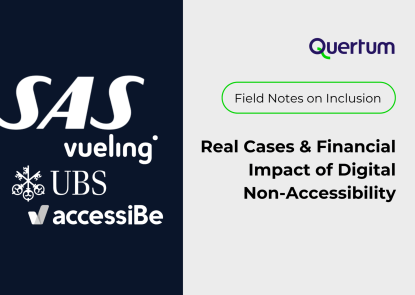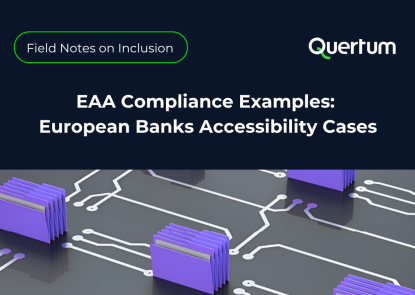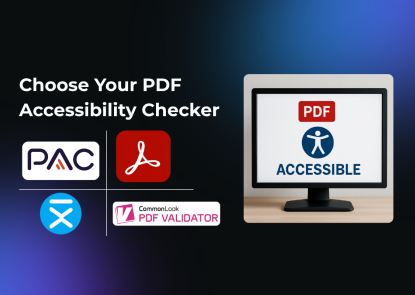EU Accessibility Act in France: Uncovering the RGAA
August 20, 2025

In our previous articles, we examined EU Accessibility Act in Poland and Germany have implemented the European Accessibility Act (EAA) or RGAA in French. France, however, starts from a different place – one of leadership. Long before the EAA, French law had already set clear rules for accessibility. The EAA does not reinvent the wheel in France, but it does tighten enforcement, expand scope, and clarify obligations for private sectors.
In this article, we break down how the EAA is being applied in France, and what this means for companies operating locally or across borders.
France’s Accessibility Evolution: From Early Laws to the EAA
France has been a pioneer in accessibility regulation, starting with Law No. 2005-102 (Montchamp Law), and continuing through the RGAA (Référentiel Général d’Amélioration de l’Accessibilité). Here is why the implementation of the EAA builds on this strong base, but brings in sharper penalties, broader private-sector coverage, and stricter expectations around proof of compliance.
When it comes to digital accessibility, France didn’t wait for the European Accessibility Act (EAA) to take action. For nearly two decades, the country has been building a legal and technical framework to ensure that websites, apps, and digital documents work for everyone — including people with disabilities.
It All Started in 2005
France passed its landmark Law No. 2005‑102 (“Loi pour l’égalité des droits et des chances”), a sweeping anti-discrimination law that made digital accessibility mandatory for public-sector websites. This law laid the foundation for what would become one of Europe’s most mature national accessibility strategies.
Enter the RGAA — A Practical Accessibility Rulebook
To turn legal principles into action, France created the RGAA (Référentiel Général d’Amélioration de l’Accessibilité) — a national technical standard that adapts WCAG guidelines into concrete testing rules. Over the years, the RGAA has evolved through several versions, staying aligned with EN 301 549 and WCAG 2.1 standards.
Since 2016, France has also required accessibility statements on public websites and mobile apps, along with regular audits and a clear process for user feedback.
2019: Aligning with the EU Web Accessibility Directive
France was ahead of the curve when the EU Web Accessibility Directive came into force. Through Decree No. 2019‑768, the country reinforced its obligations for public bodies and certain private-sector services like banks and transport. The RGAA remained the go-to standard for demonstrating compliance.
2023–2025: The EAA Expands the Playing Field
With the European Accessibility Act (EAA) now in effect, France has broadened its scope. Decree No. 2023‑931 transposes the EAA into national law, extending accessibility obligations to:
- E-commerce platforms
- Banking and payment services
- Transport apps and ticketing systems
- Consumer hardware and software interfaces
- Digital documentation and product info
This marks a shift from “just public sector” to a fully digital economy model — where most businesses will need to prove their services are usable by all.
What French Accessibility Act Requires in 2025?
Businesses must now prepare not just for WCAG 2.1 or EN 301 549 compliance, but for a French interpretation of these standards – codified in domestic law and enforced across multiple sectors.
France’s implementation adds structure and legal force to accessibility expectations, so companies must ensure that:
- Digital content follows WCAG 2.1 Level AA and EN 301 549
For PDFs, this means tagging content structures (headings, lists, tables), setting reading order, and ensuring compatibility with screen readers like NVDA or JAWS.
- Products and services function with assistive technologies like screen readers, voice recognition software, and screen magnifiers
- Accessibility statements, testing results, and feedback mechanisms are made publicly available
- Online documentation is accessible and linked clearly from physical products
- Compliance documentation is maintained in accessible way (technical files, conformity declarations)
Your PDF manuals, onboarding guides, or financial statements must not only be accessible but provably so — through technical files or audit reports.
- Labels, instructions, and UIs are legible and perceivable for users with disabilities
These requirements apply to both consumer-facing and B2B products and services, with a particular focus on e-commerce, banking, insurance, utilities, transport, and telecommunications.
What are RGAA Exemptions?
France, like most EU countries, has adopted the microenterprise exemption provided in Article 4 of the EAA. This means that:
- Businesses with fewer than 10 employees, and
- Less than €2 million in annual turnover or balance sheet total are exempt from EAA obligations
However, public sector suppliers, service providers, and certain regulated industries may still need to comply, even if technically exempt, due to overlapping laws (e.g. RGAA or sectoral requirements).
How France’s Accessibility Act is Implemented?
France transposed the EAA through a coordinated set of laws, decrees, and orders throughout 2023:
- Law No. 2023-171 introduced core accessibility principles into the consumer code and transport law
- Decree No. 2023-931 established enforcement procedures and set penalties for Class 5 infractions (up to €1,500 per breach, or more for repeated offenses)
- Order of 9 October 2023 defined accessibility rules for ICT services, banking, digital books, and e-commerce
- Order of 14 August 2023 and Decree No. 2023-778 mandated EN 301 549 compliance for e-books and software
Notably, French law avoids vague language: standards are named explicitly, and enforcement powers are clearly defined.
France’s Extra Requirements of RGAA You Need to Know About
France doesn’t stop just at aligning with the EAA. It adds layers of requirements under existing national frameworks:
- The RGAA mandates manual audits, accessibility statements, and feedback tools for public websites and apps
Manual audits ensure the real-life accessible usability. That’s why it’s essential to choose the right partner team—one that doesn’t just run documents through tools like the PAC app, but also has proven experience in delivering true accessibility. The handcrafted approach ensures compliance not by ticking boxes on a checker screen, but by testing how people of diverse abilities actually interact with content—making accessibility both compliant and genuinely usable.
- Even private companies must adopt WCAG-aligned standards when offering public-facing digital services
- Periodic reporting and public disclosures are required for certain sectors
This layered approach means that simply meeting EAA minimums isn’t enough – local compliance expectations go deeper.
Harmonised Standards to Follow
French regulators reference the same harmonised standards recognised across the EU:
- EN 301 549 – covers accessibility of ICT products and services
- WCAG 2.1 AA – the benchmark for accessible web and mobile content
For Physical Products
- Labels and manuals must support multisensory accessibility: font size, colour contrast, spacing, tactile elements
- Information must be available in alternative formats and perceivable via vision, hearing, or touch
For Digital Documentation
- PDFs, instructions, and online help must follow WCAG and be compatible with:
- Screen readers (NVDA, JAWS)
- Braille displays
- Voice commands
- Keyboard navigation
What are Deadlines and Penalties for RGAA Incompliance?
France’s EAA obligations will apply from 28 June 2025, in line with the EU-wide deadline. The law has been integrated through Law No. 2023-171, Ordonnance No. 2023-859, and Decree No. 2023-931, creating a multi-layered enforcement system.
Enforcement Bodies Rely on Sector Type
- Market surveillance authorities will oversee products and services falling under the EAA
- DGCCRF (Direction générale de la concurrence, de la consommation et de la répression des fraudes) will handle consumer market compliance
- DINUM continues to enforce the RGAA for public-sector digital services, which operates in parallel to EAA requirements
Penalties for RGAA Incomplinace
- EAA-specific violations are generally treated as Class 5 offenses in France, with fines of up to €1,500 for individuals and €7,500 for organisations, repeatable for ongoing non-compliance
Additional Penalties under Montchamp Law
Under the long-standing Law No. 2005-102 (Montchamp Law), large private-sector companies (annual turnover ≥ €250 million) can face fines of €50,000 for non-compliance with accessibility obligations, plus €25,000 for missing required declarations or accessibility plans. These penalties can recur every six months until compliance is achieved.
⚠️ Fines of €50,000 can apply not only to inaccessible websites — but also to downloadable forms, onboarding documents, or PDF manuals used in public-facing services.
This dual framework means that EAA obligations in France are reinforced by existing national laws that already carry substantial penalties for certain organisations.
Why PDF Accessibility Matters in France’s Compliance Landscape
PDFs remain one of the most widely used formats for digital content — from financial disclosures to user manuals and application forms. Under the French EAA framework, inaccessible PDFs — recurring ones and templates — can be just as non-compliant as broken websites or inaccessible apps.
Here’s where businesses often miss the mark:
- Visual-only scans with no semantic tags
- Missing alternative text for diagrams or infographics
- Incorrect reading order for screen readers
- Lack of keyboard navigation support
At Quertum, we specialise in auditing, fixing, and validating PDF documents for compliance under WCAG 2.1, EN 301 549, and RGAA 4.1 — helping you avoid fines and protect your brand.
Summary
France’s EAA implementation builds on one of Europe’s most established accessibility frameworks. Businesses must meet both the EU directive’s core requirements and long-standing national obligations under the Montchamp Law and RGAA. This results in broader scope, clearer rules, and a stronger enforcement model. Penalties range from €1,500 for standard violations to €50,000 for large companies, with recurring fines for ongoing non-compliance. Accessibility is not new in France, it is a deeply rooted legal expectation that requires early preparation and continuous compliance.
Let’s drive your Digital Transformation Together.
Schedule a free consultation with our team to explore how we can help you achieve your goals.


